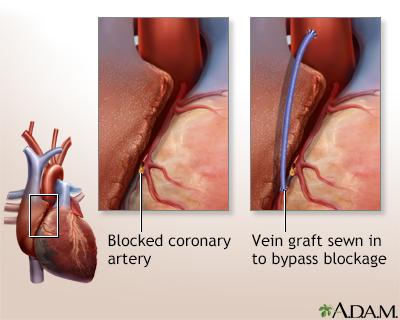Heart bypass surgery
Normal anatomy
|
|
The heart muscle is supplied blood through the coronary arteries. The left coronary artery supplies blood to the left ventricle. The right coronary artery supplies blood to the right ventricle.
|
Indications
|
|
Coronary artery bypass grafting (CABG) or heart bypass surgery is recommended when one or more coronary arteries are seriously blocked and blood supply to the heart muscle is insufficient. Several tests are done to identify the cause of the chest pain (angina), such as blood tests and x-ray studies (angiograms).
|
Procedure, part 1
|
|
Although the heart itself is not opened, the heart-lung bypass machine is used to re-route the blood from the heart while the surgery is being done to provide adequate circulation to the brain and other vital organs.
|
Procedure, part 2
|
|
Coronary bypass surgery is an open heart surgery (the chest is opened, but not the heart itself). It is done through an opening through the breast bone. While one surgeon is working on the chest, another surgeon works on taking a length of vein (saphenous vein) for the bypass through a long incision along the inside of the lower leg. The vein is sewn in above and below the blockage in the coronary artery. Alternatively, an artery from the interior aspect of the chest wall (internal mammary artery), or the arm (radial artery) is used.
|
Procedure, part 3
|
|
In many cases, more than one coronary artery must be bypassed, and both the internal mammary and radial arteries and the saphenous vein are used to perform the bypasses.
|
Aftercare
|
|
After the operation, the patient will spend 7 to 10 days in the hospital, the first 1 to 3 days in an intensive-care unit (ICU). Chest tubes will be in place for the first 2 to 3 days to drain any residual blood and fluid from around the heart. Heart functions will be monitored. The full benefits from the operation may not be ascertained until 3 to 6 months after surgery. Sexual activity may be resumed 3 to 4 weeks after surgery. All activities that do not cause fatigue are permitted, but the patient must not strain the healing chest bone (sternum).
|

Review Date:4/16/2023
Reviewed By:Mary C. Mancini, MD, PhD, Cardiothoracic Surgeon, Shreveport, LA. Review provided by VeriMed Healthcare Network. Also reviewed by David C. Dugdale, MD, Medical Director, Brenda Conaway, Editorial Director, and the A.D.A.M. Editorial team.
The information provided herein should not be used during any medical emergency
or for the diagnosis or treatment of any medical condition. A licensed medical professional
should be consulted for diagnosis and treatment of any and all medical conditions. Call 911
for all medical emergencies. Links to other sites are provided for information only -- they
do not constitute endorsements of those other sites. © 1997-A.D.A.M., Inc. Any duplication or distribution of the information contained herein is strictly prohibited.
The Agency for Health Care Administration (Agency) and this website do not claim the information on, or referred to by, this site is error free. This site may include links to websites of other government agencies or private groups. Our Agency and this website do not control such sites and are not responsible for their content. Reference to or links to any other group, product, service, or information does not mean our Agency or this website approves of that group, product, service, or information.
Additionally, while health information provided through this website may be a valuable resource for the public, it is not designed to offer medical advice. Talk with your doctor about medical care questions you may have.






